Did you know that among the staggering diversity of 28,000 orchid species, the Ludisia orchid, affectionately known as the jewel orchid, is celebrated for its distinct elegance and pet-friendly nature?
Quick Facts
| Characteristic | Detail |
|---|---|
| Countries of Origin | Southeast Asia, including Indonesia, Thailand, and Malaysia |
| Colors | Leaves are dark green with velvety texture and striking red/purple veins; flowers are white |
| Size | Compact, usually around 8-12 inches in height |
| Difficulty To Grow | Easy; considered one of the simplest orchids to care for due to its low light and humidity requirements |
| Bloom Season | Winter |
| Light Requirements | Low to medium indirect light; tolerates lower light levels than most orchids |
| Watering Needs | Keep soil consistently moist but not waterlogged |
| Temperature Range | Prefers warm conditions; 60-80°F (15-27°C) |
| Potting Medium | A well-draining, rich organic mix, similar to African violet potting soil |
| Propagation Methods | Can be propagated easily by division or from leaf cuttings |
| Common Pests and Diseases | Watch for common houseplant pests like aphids and mealybugs; generally robust |
| Fragrance | The flowers are not particularly fragrant |
| Lifespan/Longevity | Can live for many years with proper care; is perennial |
| Conservation Status | Not listed as endangered, but habitat destruction could impact wild populations |
| Unique Features | Noted for its attractive foliage rather than its flowers; popular as a houseplant for its decorative leaves |
Unlike any other indoor orchid variety, its dark burgundy leaves shimmer like the finest velvet, drawing in enthusiasts around the globe.
As a passionate orchid connoisseur, I have been mesmerized by the Ludisia orchid’s exceptional beauty and am eager to share how it enriches any space with its presence, without compromising the safety of our beloved pets.
My journey with these botanical gems has shown me that for those with an eye for elegance, the Ludisia stands apart as a statement piece in the world of flora.
Its lush, rich foliage offers a matte contrast against the typical glossy greens found in most households, and this is but a whisper of the aesthetic impact it can make as part of any indoor collection.
The safe haven it provides for your furry companions allows the Ludisia orchid elegance to not only decorate but also harmoniously integrate into any pet-friendly home.
Key Takeaways
- Jewel orchids represent a uniquely pet-friendly and elegant addition to indoor plant collections.
- Ludisia orchid elegance enhances home aesthetics with its lush, velvet-like dark leaves.
- Understanding the needs of Ludisia can appeal to and instruct both novice and lifelong orchid enthusiasts.
- Choosing and caring for indoor orchid varieties can amalgamate both staggering beauty and domestic harmony.
- Discovering this gem within the extensive orchid family unveils new horizons for botanical aficionados.
Introduction to Ludisia, the Jewel Orchid
Among the countless members of this vast family lies the Ludisia, or more poetically known as the jewel orchid. My personal Ludisia discovery was akin to uncovering a hidden gem in a sea of greenery.
Not renowned for the typical orchid flower flamboyance, they captivate with their opulent, velvet-textured leaves and understated blooms.
Ludisia holds a special place, adorned by those who appreciate the subtler nuances of the orchid world.
Understanding Orchid Genera
Embarking on the journey of orchid genera identification is both daunting and exhilarating.
Each genus carries with it unique characteristics, care requirements, and environmental preferences, which can range from the high, misty cloud forests to the warm, tropical lowlands.
Specific traits like pseudobulbs in Oncidium, the monopodial growth of Vanda, or the sympodial nature of Cymbidium, furnish enthusiasts and botanists with cues for unraveling the complexities of this family.
| Genus | Distinctive Feature | Preferred Habitat |
|---|---|---|
| Cattleya | Large, fragrant flowers | Epiphytic, tropical Americas |
| Dendrobium | Ample pseudobulbs | Varied, Asia and Oceania |
| Ludisia | Velvety foliage | Terrestrial, Southeast Asia |
| Phalaenopsis | Long-lasting flowers | Epiphytic, warm regions |
| Vanilla | Produces vanilla pods | Terrestrial/vine, tropical climates |
Understanding these and other peculiar details of the numerous jewel orchid varieties and their relatives is more than mere intellectual fulfillment—it’s a celebration of nature’s infinite artistry.
In the folds of an orchid’s petals and the pattern of its leaves lies a story waiting to be told, shared, and cherished by those of us lucky enough to discover it.
Caring for Ludisia Orchids
Delving into the specific requirements of the Ludisia orchid care regimen ensures its characteristic leaves and blooms remain as lustrous as they are meant to be.
Mastering these details is pivotal for any enthusiast to maintain the plant’s health and beauty.
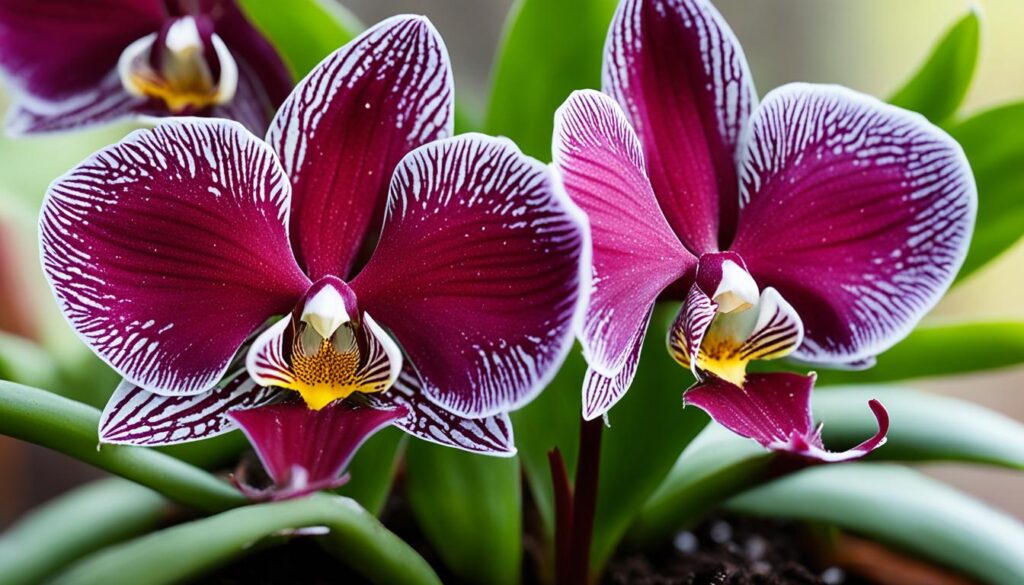
Optimal Lighting Conditions
When I situate my Ludisia, I carefully select a spot that offers plenty of bright, but indirect light. The ideal lighting for orchids like Ludisia is crucial, as it enables their leaves to maintain their vibrant colors without risk of scorching.
Shielding them from direct sunlight by diffusing the light with curtains or blinds can work wonders.
Watering and Humidity Preferences
A consistent watering regimen is central to Ludisia orchid care. The soil should remain evenly moist but never waterlogged. Ensuring a humidity level that approximates their native tropical habitat is essential.
I find using a humidifier or pebble tray increases ambient moisture, providing an optimal growing environment.
Tips for Repotting and Soil Choices
When repotting Jewel orchids, the choice of soil is as important as the frequency of this task. A well-draining orchid mix that allows air to the roots yet retains moisture is ideal.
I recommend a repotting frequency of every couple of years or when the orchid outgrows its pot, to support continual health and growth.
Designing with Ludisia: Aesthetic Appeal and Placement
In my experience as a devoted fan of home aesthetics, the role of plants in interior design is pivotal. When it comes to embedding natural elements into our living spaces, the Jewel orchid, or Ludisia, isn’t just another houseplant; it’s a statement of elegance and tranquility.
With its stunning burgundy leaves, Ludisia infuses a sense of sophisticated color into rooms, making home decor with Jewel orchids an artist’s dream for vibrant, yet serene ambiance.
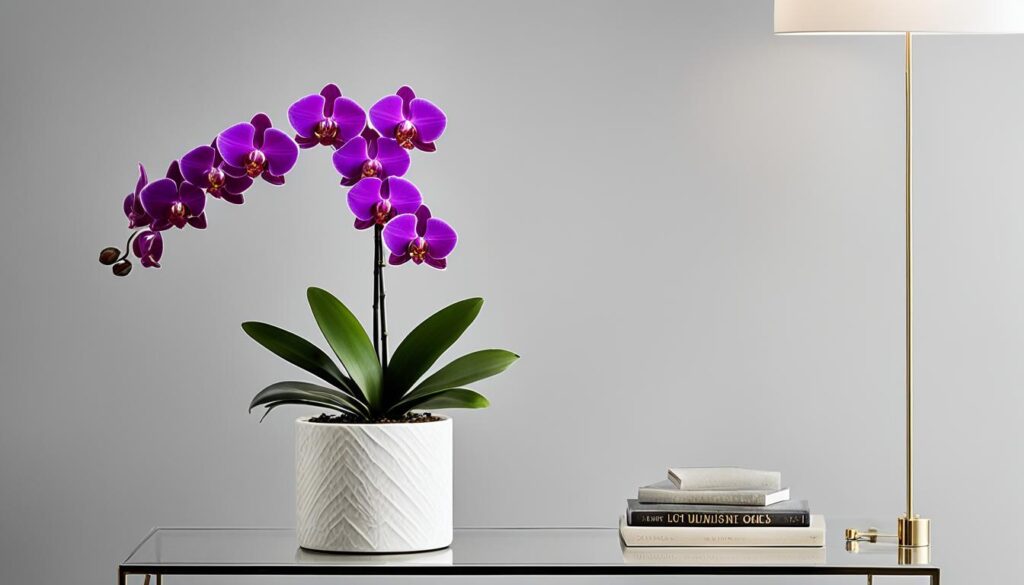
Incorporating Jewel Orchids into Home Decor
Explore the potential of Ludisia in diverse interior settings. Its aesthetic placement can be the centerpiece on a coffee table or a subtle accent in a bookshelf arrangement.
The glossy leaves of Ludisia reflect soft lighting beautifully, creating an alluring highlight in dim corners or as part of a larger botanical display.
Complementary Plants for Ludisia Orchids
Finding companion plants to accompany your Ludisia can be quite an enjoyable pursuit. Ferns, for instance, offer textural diversity and a fresh green backdrop against which the dark leaves of Ludisia can truly shine.
Here is a compilation of companion plants that harmonize with the Jewel orchid:
| Companion Plant | Reasons for Compatibility | Safety for Pets |
|---|---|---|
| Boston Fern | Adds lush greenery and volume, enhancing the contrast with Ludisia’s dark foliage | Yes |
| Ponytail Palm | Unique structure provides a sculptural element; drought-tolerant balance to orchid’s moisture needs | Yes |
| Snake Plant | Vertical lines complement Ludisia’s horizontal form; tolerant of low light conditions | Yes, mostly (mildly toxic if consumed in large quantities) |
| Spider Plant | Arching leaves create a cascading effect; easy to grow and maintain | Yes |
| Peace Lily | Offers elegant white blooms that resonate with Ludisia’s flowers; purifies indoor air | Yes, although mildly toxic when ingested, so placement should be considered |
Pairing these plants with Ludisia not only promotes a visually cohesive and lush tableau but also ensures a pet-safe environment, allowing the whole family to enjoy the space without concern.
Be mindful of the individual care needs of each plant to preserve their health and enhance their beauty. By thoughtfully selecting and positioning these companions, you can create a living mosaic that captivates and calms all who enter your sanctuary.
Ludisia Orchids as Pet-Friendly Plants
As pet owners, we seek to create a safe haven at home, not just for ourselves but for our treasured animal companions.
The choice of houseplants plays a critical role in this, as it is paramount to ensure the safety of our pets who may be inclined to nibble on foliage. In this context, pet-friendly orchids like Ludisia offer an ideal synergy of beauty and non-toxic serenity, securing their spot as safe indoor plants for pets.
Safe Indoor Gardening with Pets
Indoor gardening can be a joyful and therapeutic hobby, yet it mandates mindfulness when our curious pets join the mix.
The lush leaves of Ludisia, their subdued, garnet glow, serve not only as a visual feast but also as comfort, knowing they aren’t among the toxic houseplants that could jeopardize our pets’ health.
Alternatives to Toxic Houseplants
In pursuit of non-toxic houseplant alternatives, Ludisia excels as an impeccable choice. For those of us who adore both our greenery and our pets, it’s a breath of fresh air to know that such an elegant orchid can coexist peacefully with our furry friends.
Below is a comparison of commonly found plants and their level of pet-friendliness, underlining the importance of selecting safe indoor plants.
| Houseplant | Pet-Friendly | Toxic to Pets | Visual Appeal |
|---|---|---|---|
| Ludisia Orchid | Yes | No | Elegant burgundy foliage with delicate white flowers |
| Peace Lily | No | Yes | Lush green leaves with distinctive white blooms |
| Spider Plant | Yes | No | Graceful green and white striped leaves |
| Pothos | No | Yes | Heart-shaped leaves, variegated in green and yellow |
| Boston Fern | Yes | No | Feathery fronds that create a lush fullness |
Ludisia’s distinction as a safe indoor plant for pets not only promotes the well-being of our cats and dogs but also empowers us, the plant lovers, to cultivate an environment rich with diversity and safety.
This harmonious blend is what truly personifies the spirit of pet-friendly indoor gardening.
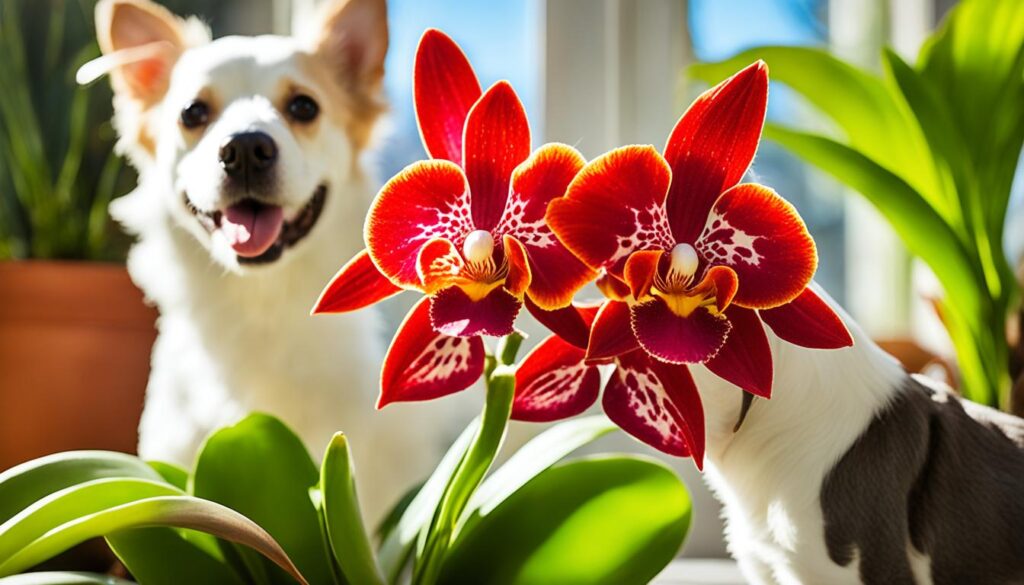
The Remarkable Resilience of Ludisia Orchids
As I delve deeper into the resilient nature of Ludisia orchids, I’m constantly impressed by their robust character. The resilient Ludisia orchid not only graces the indoors with its shimmering beauty but it also withstands environmental fluctuations with remarkable ease.
As adaptable indoor plants, they serve as an exemplar of durability and elegance, creating a seamless bond between form and function.
Adaptability in Different Environments
The adaptability of Ludisia orchids is astounding. They manage to thrive in a range of indoor conditions, which not only speaks to their versatility but also makes them a superb choice for novices and experts alike.
Whether it’s a shaded corner or a bright living room, these orchids adjust without compromise, proving their status as adaptable indoor plants.

Resistance to Common Orchid Pests and Diseases
One of the most persuasive arguments for choosing Ludisia orchids is their innate resistance to pests and diseases, a common affliction in other orchid species.
This pest-resistant attribute translates into fewer concerns for orchid caretakers, assuring a thriving display of foliage and flowers with minimal intervention.
| Ludisia Orchid Traits | Benefits | Comparative Advantage |
|---|---|---|
| Shade Tolerance | Flexible placement in various indoor light conditions | Superior to many orchids requiring strict light regimens |
| Moisture Affinity | Manageable watering schedule, less prone to root rot | More forgiving than orchids with delicate watering needs |
| Pest Resistance | Reduced need for chemical treatments, safer for households | Lower maintenance compared to pest-prone species |
In conclusion, my experience with resilient Ludisia orchids has been nothing short of delightful. Their capability to adapt and resist common issues impresses me continually, making them an indispensable component of my indoor plant collection.
Pest-resistant orchids like Ludisia not only offer peace of mind but also stand as a testament to the beauty and tenacity of the orchid family.
Propagation Techniques for Ludisia Orchids
As a lover of these striking plants, I can attest to the satisfaction found in propagating Ludisia orchids.
Both dividing orchid rhizomes and cloning Jewel orchids stand as testament to the plant’s forgiving nature, making it possible for enthusiasts to spread the grace of these botanical gems far and wide.
Dividing Jewel Orchid Rhizomes
Dividing the rhizomes of Ludisia orchids is a hands-on way to foster new growth and share it with fellow orchid lovers. It’s a tradition as much as it is a propagation technique, where one can feel the vitality of each cut and the anticipation of new life.
The best time to embark on this division process is during repotting, when the orchids are at their most robust.
Steps for Successful Cloning
While cloning may sound like a feat fit for a lab, it’s a surprisingly accessible method to propagate these orchids.
By taking a leaf cutting and following careful steps to encourage roots to form, cloning Jewel orchids can yield numerous identical offspring, preserving the genetic makeup of a particularly cherished plant.

To ensure that the art and science of propagating Ludisia orchids continue to flourish, I’m sharing my experience and success stories.
Whether you’re a novice or a seasoned grower, learning the intricacies of dividing rhizomes and cloning means that the splendor of Ludisia will keep enriching homes and collections across the country.
Blooming Patterns and Seasonal Care
As I delve deeper into the care of Ludisia orchids, I become more attuned to their rhythm – the natural ebb and flow of their growth cycles. It’s fascinating how these periods of dormancy and active growth dictate when the spectacular blooms of Ludisia will grace our indoor gardens.
To truly maximize flower production, recognizing and respecting these cycles is pivotal, as it directly influences the vibrancy and quantity of blossoms.
Recognizing Growth Cycles
Understanding the orchid growth cycles involves observing the subtle shifts in the plant’s life—a process I find both rewarding and insightful. By closely monitoring these changes, I am able to provide the targeted care that nurtures the plant’s development.
It’s through this dedication that I gain the satisfaction of seeing Ludisia orchids reach their full potential, transforming spaces with their bewitching flowers during the blooming seasons.
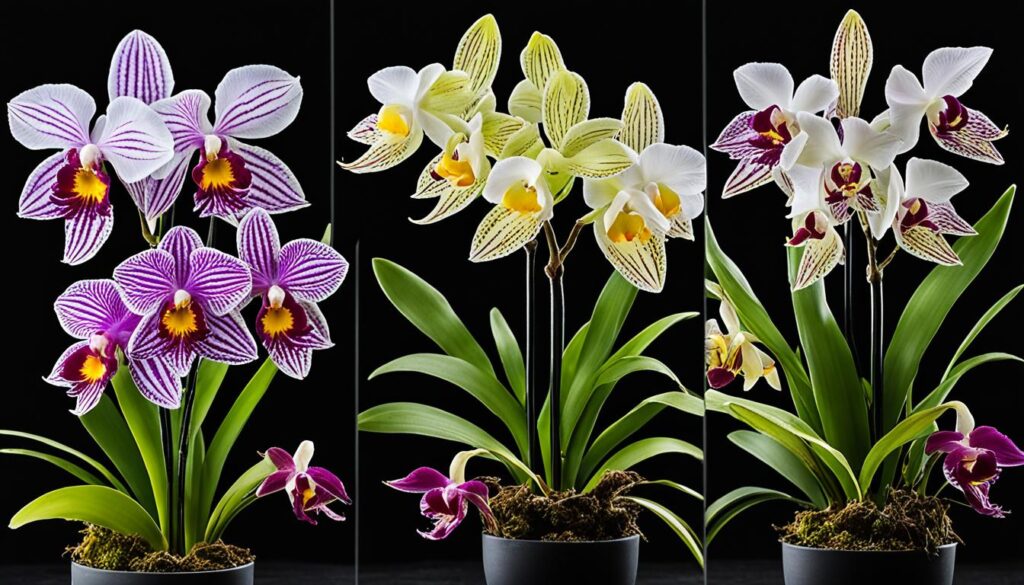
Anticipating and Enhancing Flower Production
The anticipation of flower spikes on my Ludisia orchids is reminiscent of awaiting the finale of a grand symphony. To usher in this delightful phase, I implement strategic care methods – creating an environment that encourages blooming while also replicating their native humid and shaded habitats.
Key nutrients, adequate moisture, and precise lighting are all part of my arsenal to ensure the blossoms are not only forthcoming but also abundant and healthy.
In my journey nurturing these living jewels, I’ve learned that patience and attentiveness are my greatest allies. These orchids remind me that beauty unfolds in its own time, and with the right conditions, I can look forward to a bounteous display reflective of the care poured into each season.
Indeed, each year with Ludisia is a chapter filled with growth, learning, and the incomparable joy of blooming seasons that never cease to amaze.
Conclusion
In this exploration of the radiant Ludisia orchids, also known as jewel orchids, we’ve delved into their elegant charm, which has captured the hearts of both the green-thumbed veterans and those newly introduced to the world of orchid care.
These plants blend beauty with resilience, offering a spectacle of deep, velvet-like leaves and a cascade of white blossoms that can amplify the aesthetics of any space they grace.
It is clear that cultivating Ludisia orchids is a journey worth embarking upon, one that rewards growers with its modest care requirements and stunning visual appeal.
Summation of Ludisia Orchids Charms
As we’ve observed, the luminescent allure of the Ludisia orchid is undeniable. My personal experiences have affirmed that its jeweled leaves bring a sophisticated flair to any indoor garden, while its pet-friendly nature reassures that our beloved animals are safe.
Growing Ludisia orchids is akin to adorning one’s living space with natural jewels that continuously sparkle with vivacity. I have enjoyed every moment with these orchids, embracing their capacity to thrive with minimal intervention and yet still dazzle with their sophisticated blooms.
Encouragement for Novice and Expert Growers Alike
I extend my earnest encouragement to both novice gardeners seeking to enhance their living quarters with a touch of nature’s elegance and expert horticulturists looking to refine their collection with a specimen that exudes both poise and robustness.
Whether you’re mastering beginner orchid care or applying expert horticulture tips to your practice, the cultivation of Ludisia orchids promises a fulfilling experience.
Embrace these enchanting plants and let their jeweled embrace become a cornerstone of your indoor garden sanctuary.
FAQ
What makes Ludisia orchids unique among other orchid varieties?
Ludisia orchids, often referred to as jewel orchids, are unique for their striking, deep burgundy leaves with pinkish veins that shine like jewels. Unlike other orchids whose appeal lies primarily in their blooms, Ludisia captivates with its foliage, making it an attractive indoor plant year-round.
How can I identify different orchid genera?
Identifying different orchid genera involves examining characteristics such as leaf shape, root structure, bloom type, and growth patterns. Each genus has distinct features that set it apart. For example, Cattleya orchids usually have large, showy blooms, while Phalaenopsis orchids are known for their moth-shaped flowers.
What are the best lighting conditions for Ludisia orchids?
Ludisia orchids thrive in bright, indirect light. Direct sunlight can scorch their leaves, so it’s best to place them in a spot where they’ll receive filtered sunlight, such as near a north or east-facing window with sheer curtains.
How often should Ludisia orchids be watered?
Watering should be consistent, aiming to keep the soil moderately moist. Ludisia orchids prefer not to dry out completely between waterings. It’s essential to use well-draining soil and to avoid letting the plant sit in standing water to prevent root rot.
Can I use normal potting soil for repotting my Ludisia orchid?
No, normal potting soil is not recommended for Ludisia orchids. Instead, use an orchid-specific mix that allows for proper drainage and air circulation, which are critical for the health of the orchid’s roots.
What plants complement Ludisia orchids in home decor?
For creating an appealing ensemble that’s also pet-friendly, consider pairing Ludisia orchids with other plants that thrive in similar conditions, such as Boston ferns or ponytail palms. These plants can enhance the tropical feel of your space and are safe for pets.
How do I know if my houseplants are safe for my pets?
To ensure your houseplants are safe for pets, consult a reliable resource such as the ASPCA’s list of non-toxic plants. Ludisia orchids are a great choice as they are known to be pet-friendly, posing no risk to your cats and dogs.
What attributes contribute to the resilience of Ludisia orchids?
Ludisia orchids are resilient due to their adaptability to various indoor environments and their resistance to many pests and diseases that commonly affect orchids. Their ability to thrive in a range of conditions makes them a durable choice for indoor gardeners.
What techniques can I use to propagate my Ludisia orchid?
You can propagate Ludisia orchids by dividing the rhizomes or through cloning. Dividing is a straightforward method where you separate the plant at the rhizome, while cloning involves more detailed steps such as taking stem cuttings and inducing root growth.
How can I enhance my Ludisia orchid’s bloom production?
To enhance bloom production, it’s important to understand the orchid’s growth cycle and provide proper seasonal care. Ensure that your Ludisia receives the right amount of light, humidity, and nutrients, especially as it approaches its blooming season.

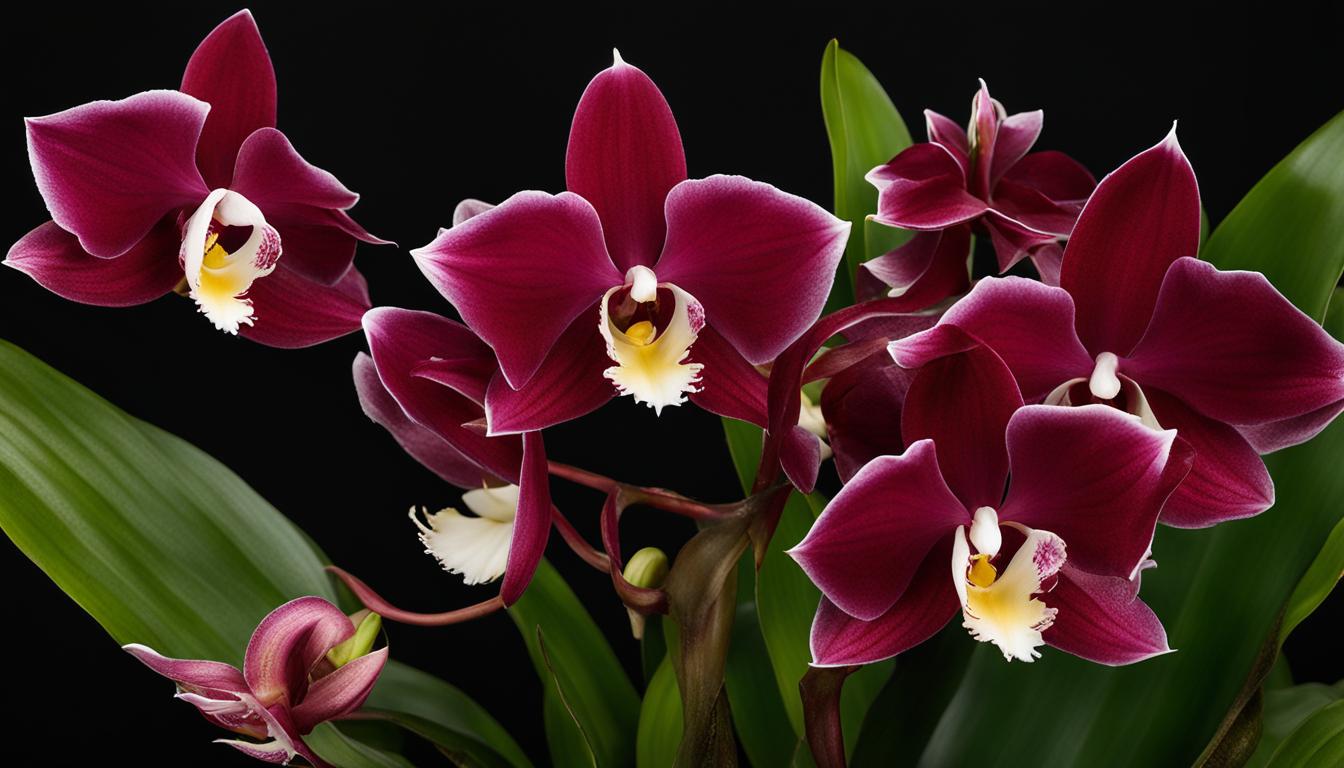
Leave a Reply